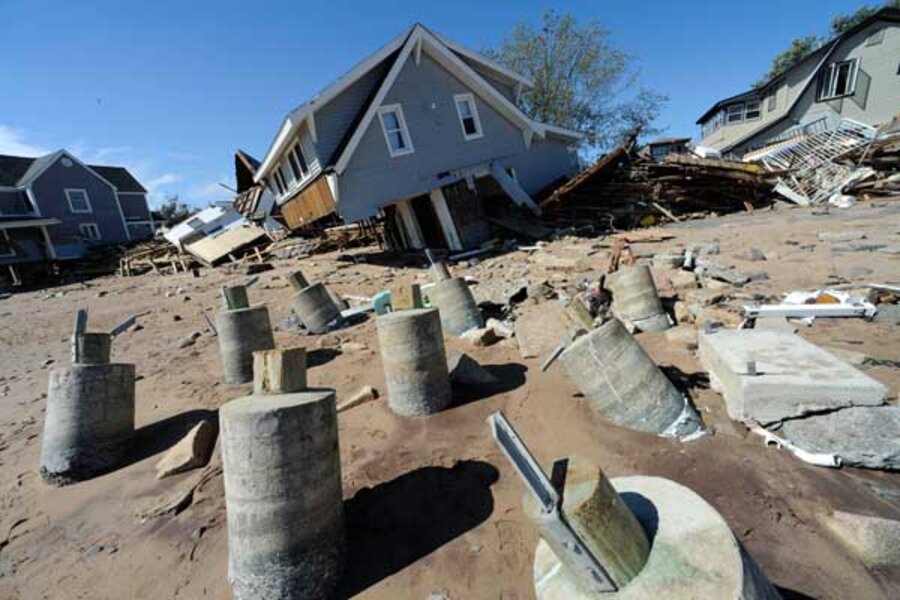Hurricane Irene by the numbers: state by state damage reports
Loading...
| Boston
From North Carolina to Vermont, federal officials fanned out along the storm-stricken East Coast Tuesday inspecting damage hurricane Irene inflicted over the weekend.
Some 42 deaths have been attributed directly or indirectly to the storm, which struck North Carolina's Outer Banks as a category 1 hurricane last Saturday morning. It made its final landfall Sunday morning at New York City as a tropical storm, then worked its way into New England finally to lose its tropical-storm status over central Maine on Monday.
Along the way high winds, storm surge, and especially the storms torrential rains caused damage initially estimated at between $7 billion and $10 billion.
In Vermont, Craig Fugate, head of the Federal Emergency Management Agency, joined the state's governor, Peter Shumlin (D), along with Sen. Bernie Sanders (I) and Rep. Peter Welch (D) Monday to survey some of the damaged areas.
In an interview with the New England Cable Network prior to the survey trip, Governor Shumlin cited three confirmed deaths from the storm. In addition he noted "a huge loss of homes and businesses ... it seems like there's no end to the extraordinary destruction – not to mention the roads, bridges, and infrastructure."
All along Irene's path, some of the most welcome progress has come as utility crews have restored electricity to homes and businesses throughout the region.
Power outages
By midday Monday, some estimates put the number of utility customers without power in the 12 states Irene affected at about 2.5 million, down substantially from the 5 million estimated the day before.
In Maryland, for example, Irene initially cut power to some 800,000 customers as of Sunday night, according to Ed McDonough, a spokesman for Maryland's Emergency Management Agency. Since a typical customer account provides electricity for more than one person, those 800,000 customers represent roughly 2 million people.
Today, about 250,000 customers are still waiting to reconnect to the grid.
In New York, power has been restored to about 530,000 customers of the 950,000 initially affected by Irene, according to Dennis Michalski, a spokesman for the state's Division of Homeland Security and Emergency Services.
In North Carolina, some 1,000 residents remain in emergency shelters, while in Virginia, the number has dwindled to 17.
Continuing threats
From a public-safety standpoint, some of the biggest challenges state and local officials face involve people coming into contact with downed power lines, often as they try to remove damaged or downed trees.
In Maryland, one of the three storm-related deaths reported to the state so far occurred because the individual was overcome by fumes from an improperly installed emergency generator.
Water quality is another concern. US Geological Survey scientists are sampling water from six major rivers in the Northeast – from the Susquehanna, which flows out of New York into the Chesapeake Bay, to Boston's Charles River – for sewage contamination. In Virginia, residents in some of the smaller communities in the areas Irene affected are being asked to boil water before drinking it as officials bring water-treatment facilities back on line and test for contamination.
Even as power comes back, teams of federal and state damage assessors are moving into stricken areas to assess damage to homes, businesses, and infrastructure. Those assessments will become the basis for figuring out how much federal disaster aid will be needed to repair homes and businesses.
Floodwaters in New York and Vermont
Yet as assessments get underway at the southern end of Irene's path, communities at the northern end are still struggling with the immediate effects of floodwaters that poured down mountainsides in Vermont as well as in New York's Catskill and Adirondack Mountains.
In both states, roads to and from rural communities have been washed out. At least three of Vermont's iconic covered bridges succumbed to the floods. National Guard units are flying food and water into stranded communities isolated by flood damage to roads and bridges.
In Vermont, 260 roads and 30 bridges are impassable. Some 400 people have been isolated in Killington, Vt., a popular ski and vacation spot.
In New York, "26 counties have been identified with significant damage – flooding, trees down, power outages," Mr. Michalski says. The mostly mountainous counties most affected by flooding "are still in life-safety response."
"The Catskills received between 10 and 12 inches of rain," he says. "That's a heck of a lot."
For affected communities, rainfall from Irene represented close to 25 percent of some communities' typical average annual rainfall.
"We still have to wait for water to recede in many places" to start toting up the damage, Michalski says. In a sentiment many of his counterparts undoubtedly share, assessing effects and beginning the process of recovery "will be going on for months."





